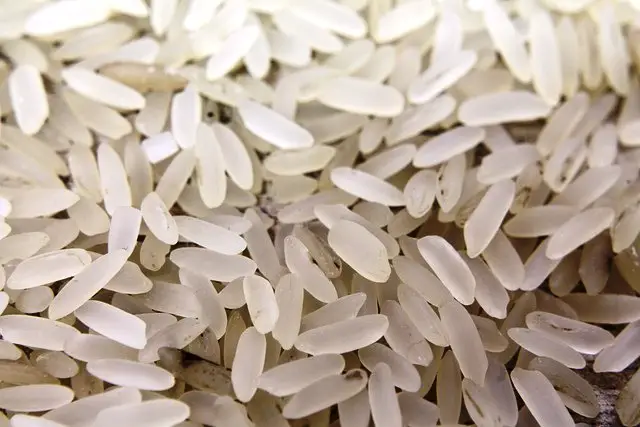Estimated reading time: 6 minutes

You’ll find rice on just about every list of foods to store in the emergency pantry. Rice is inexpensive and a source of complex carbohydrates, vitamins, and protein. It is gluten-free, allergy-friendly, and the foundation of many meals.
But if you’ve experienced spoilage, insect infestation, or other issues with your rice, you may wonder how the popular grain earned its place on survival pantry lists.
The answer lies in the type of rice you store and how you store it. This article offers tips on the types of rice that store best and how to store rice long-term.
What type of rice stores best long-term?
When it comes to extended shelf life, focus on white rice varieties. Also called polished rice, white rice no longer has its bran layer. It is the oil found in the bran layer that causes brown, black, and purple rice varieties to oxidize and thus spoil more quickly.
The three main types of white rice sold in the United States are long, medium, and short.
Long grain white rice is about three times longer than it is wide. It becomes firm and fluffy after cooking.

Medium grain white rice is two- to three times longer than it is wide. Cooked medium grain rice is soft, moist, and somewhat sticky.

Short grain white rice is less than two times longer than it is wide. Often called sushi rice, short grain rice becomes very sticky.

Specialty white rice varieties include Jasmine, Arborio, Basmati, Japanese, Toro, Waxy, and others. Instant white rice can also be stored long-term, but it is more expensive to purchase in bulk quantities than uncooked varieties.
How to store rice for decades
When storing rice, the four problems to avoid are temperature, humidity, oxygen, and pests.
1. Temperature
Store rice in a cool location that is away from light and heat sources. A basement, closet, or even under a bed can work. The ideal temperature to store rice long-term is 40°F.
2. Humidity
Rice can absorb moisture readily and is susceptible to mold. Therefore, for best results, remove rive from its store packaging and store it in tightly sealed containers. (See below for more.)
3. Oxygen

When rice is exposed to oxygen, spoilage can occur. You can avoid this problem by using sealed containers and oxygen absorbers.
4. Pests
Insect legs and larvae can be in a package of rice when you purchase it and yet be invisible to the eye. Before storing your rice, place it in the freezer for three days to kill insects. Also, pack rice in rodent-proof five-gallon buckets.
What supplies do you need to store rice long-term?

For long-term protection, store rice in sealed Mylar bags that are at least 5mm thick. Place food-grade oxygen absorbers in the bags. You can seal the bags using a clothes iron, hair straightener, or vacuum sealing device like this one.
Then, place the sealed bags in food-grade five-gallon buckets that have tight-fitting lids. Use a permanent marker to label the bags and the buckets with the contents and the date of storage.
This method allows you to remove what you need when you need it without exposing your entire supply of rice to the elements.
If you’d like to avoid plastic contacting your food, another option is to store white rice in vacuum-sealed Mason jars. A potential downside to using Mason jars is that they are breakable and heavy.
FAQs on long-term rice storage
How much rice should I store?
While federal agencies, like FEMA, recommend a minimum of storing three days of emergency food in your home for each family member, the reality is that many of today’s crises last longer than that. Utah State University recommends storing 25 to 60 pounds of rice per person per year.
Where can I buy rice in bulk quantities?
Buying rice in large quantities can save money. Many online sites, including the Church of Latter Day Saints, have bulk food stores. Among the many choices on Amazon are 25 pounds of long-grain rice in a five-gallon bucket or a 50-pound bag of long-grain white rice.
If you’d like to avoid shipping costs, try local ethnic grocery stores and membership-based warehouse stores like Sam’s Club and Costco.
Can I store rice in the freezer?
Yes, you can keep rice in the freezer. However, rice does not need to be frozen or refrigerated, so it makes sense to save space in your appliances for foods that need to be kept there. And remember that many emergencies involve power outages.
How can I tell if uncooked rice has gone bad?
Trust your senses to help you determine if rice is safe to eat.
- A change in color or texture can indicate spoilage.
- Rice has little to no odor. A sour or musty smell indicates the presence of moisture and oxidation.
- If the rice tastes off, throw it out.
How can I cook rice when the power is out?
You’ll need water and a heating source to prepare rice when the grid is down. Here are some videos showing how to cook rice when the power is out.
- 8 Ways to Cook Indoors Without Electricity
- How to Bake Without an Oven
- The Ultimate Guide to Cooking Without Power
A study by Brigham Young University found that the quality of rice stored in proper conditions did not decrease significantly over 30 years. Inexpensive, versatile, and easy to prepare, rice has earned its spot among the top foods to store in your emergency pantry.
You May Also Like:












First of all, they’re making fake rice out of a plastic polymer. It’s toxic to humans and almost indistinguishable from real rice. Do the hot pan melt test. Real rice doesn’t melt. Then if you’re convinced, these storage ideas are spot on
Great information! My Mom (God rest her soul) used instant rice all the time. Something I have never used. But, it is good to know that instant rice can be stored for 4-5 years! Definitely has some good attributes like less water and cook time in a grid down situation.